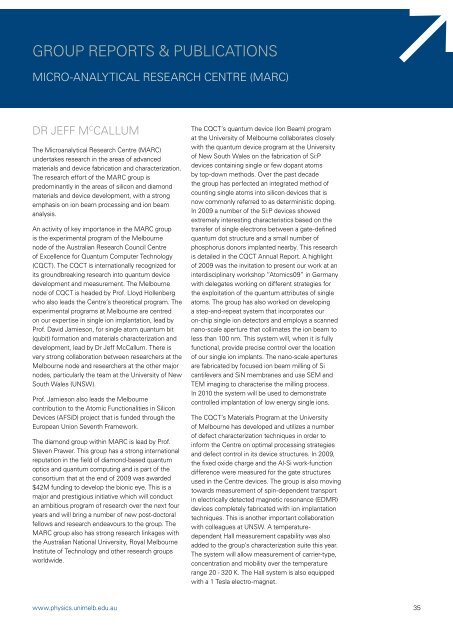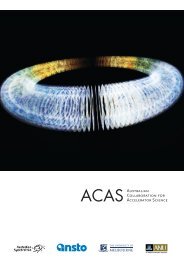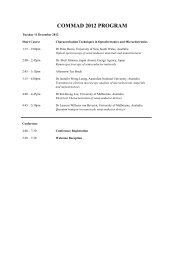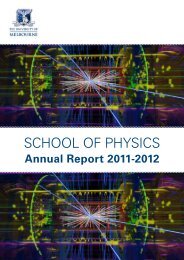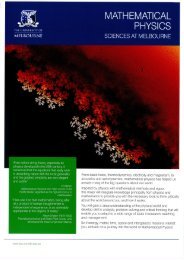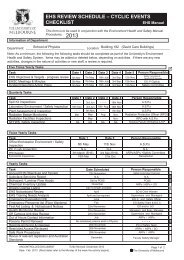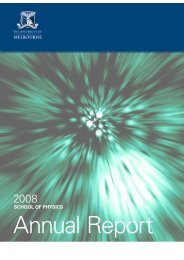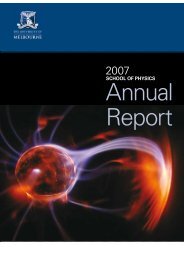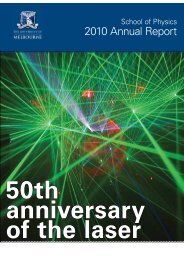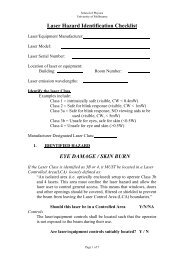Annual Report 2009.pdf - School of Physics - University of Melbourne
Annual Report 2009.pdf - School of Physics - University of Melbourne
Annual Report 2009.pdf - School of Physics - University of Melbourne
- No tags were found...
You also want an ePaper? Increase the reach of your titles
YUMPU automatically turns print PDFs into web optimized ePapers that Google loves.
group reports & publicationsmicro-analytical research centre (MARC)dr jeff m c callumThe Microanalytical Research Centre (MARC)undertakes research in the areas <strong>of</strong> advancedmaterials and device fabrication and characterization.The research effort <strong>of</strong> the MARC group ispredominantly in the areas <strong>of</strong> silicon and diamondmaterials and device development, with a strongemphasis on ion beam processing and ion beamanalysis.An activity <strong>of</strong> key importance in the MARC groupis the experimental program <strong>of</strong> the <strong>Melbourne</strong>node <strong>of</strong> the Australian Research Council Centre<strong>of</strong> Excellence for Quantum Computer Technology(CQCT). The CQCT is internationally recognized forits groundbreaking research into quantum devicedevelopment and measurement. The <strong>Melbourne</strong>node <strong>of</strong> CQCT is headed by Pr<strong>of</strong>. Lloyd Hollenbergwho also leads the Centre’s theoretical program. Theexperimental programs at <strong>Melbourne</strong> are centredon our expertise in single ion implantation, lead byPr<strong>of</strong>. David Jamieson, for single atom quantum bit(qubit) formation and materials characterization anddevelopment, lead by Dr Jeff McCallum. There isvery strong collaboration between researchers at the<strong>Melbourne</strong> node and researchers at the other majornodes, particularly the team at the <strong>University</strong> <strong>of</strong> NewSouth Wales (UNSW).Pr<strong>of</strong>. Jamieson also leads the <strong>Melbourne</strong>contribution to the Atomic Functionalities in SiliconDevices (AFSiD) project that is funded through theEuropean Union Seventh Framework.The diamond group within MARC is lead by Pr<strong>of</strong>.Steven Prawer. This group has a strong internationalreputation in the field <strong>of</strong> diamond-based quantumoptics and quantum computing and is part <strong>of</strong> theconsortium that at the end <strong>of</strong> 2009 was awarded$42M funding to develop the bionic eye. This is amajor and prestigious initiative which will conductan ambitious program <strong>of</strong> research over the next fouryears and will bring a number <strong>of</strong> new post-doctoralfellows and research endeavours to the group. TheMARC group also has strong research linkages withthe Australian National <strong>University</strong>, Royal <strong>Melbourne</strong>Institute <strong>of</strong> Technology and other research groupsworldwide.The CQCT’s quantum device (Ion Beam) programat the <strong>University</strong> <strong>of</strong> <strong>Melbourne</strong> collaborates closelywith the quantum device program at the <strong>University</strong><strong>of</strong> New South Wales on the fabrication <strong>of</strong> Si:Pdevices containing single or few dopant atomsby top-down methods. Over the past decadethe group has perfected an integrated method <strong>of</strong>counting single atoms into silicon devices that isnow commonly referred to as deterministic doping.In 2009 a number <strong>of</strong> the Si:P devices showedextremely interesting characteristics based on thetransfer <strong>of</strong> single electrons between a gate-definedquantum dot structure and a small number <strong>of</strong>phosphorus donors implanted nearby. This researchis detailed in the CQCT <strong>Annual</strong> <strong>Report</strong>. A highlight<strong>of</strong> 2009 was the invitation to present our work at aninterdisciplinary workshop “Atomics09” in Germanywith delegates working on different strategies forthe exploitation <strong>of</strong> the quantum attributes <strong>of</strong> singleatoms. The group has also worked on developinga step-and-repeat system that incorporates ouron-chip single ion detectors and employs a scannednano-scale aperture that collimates the ion beam toless than 100 nm. This system will, when it is fullyfunctional, provide precise control over the location<strong>of</strong> our single ion implants. The nano-scale aperturesare fabricated by focused ion beam milling <strong>of</strong> Sicantilevers and SiN membranes and use SEM andTEM imaging to characterise the milling process.In 2010 the system will be used to demonstratecontrolled implantation <strong>of</strong> low energy single ions.The CQCT’s Materials Program at the <strong>University</strong><strong>of</strong> <strong>Melbourne</strong> has developed and utilizes a number<strong>of</strong> defect characterization techniques in order toinform the Centre on optimal processing strategiesand defect control in its device structures. In 2009,the fixed oxide charge and the Al-Si work-functiondifference were measured for the gate structuresused in the Centre devices. The group is also movingtowards measurement <strong>of</strong> spin-dependent transportin electrically detected magnetic resonance (EDMR)devices completely fabricated with ion implantationtechniques. This is another important collaborationwith colleagues at UNSW. A temperaturedependentHall measurement capability was alsoadded to the group’s characterization suite this year.The system will allow measurement <strong>of</strong> carrier-type,concentration and mobility over the temperaturerange 20 - 320 K. The Hall system is also equippedwith a 1 Tesla electro-magnet.www.physics.unimelb.edu.au 35


